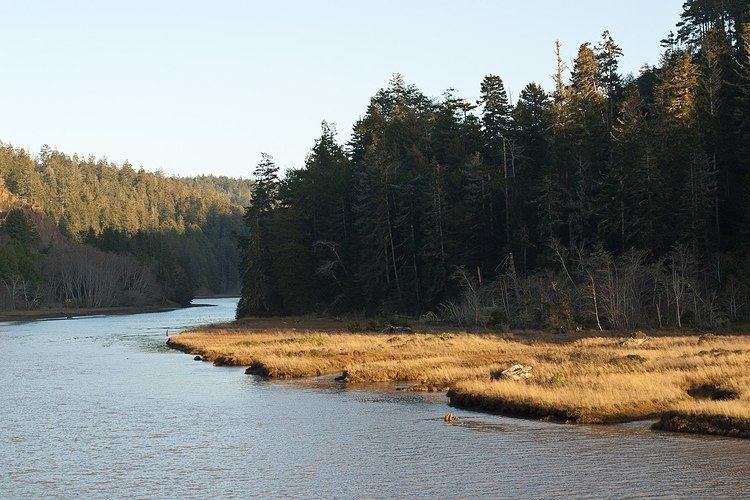- location Mendocino, California | - elevation 0 ft (0 m) | |
 | ||
- location 7 mi (11 km) south of Willits, California | ||
The Big River is a 41.7-mile-long (67.1 km) river in Mendocino County, California, draining an area of about 181 square miles (470 km2). The Big River watershed borders the watersheds of the Noyo River to the north, the Eel River and Russian River to the east, and the Little River, Albion River, and Navarro River to the south.
Contents
Map of Big River, CA, USA
The river's headwaters are thirty miles inland from the Pacific Ocean in the Mendocino Range, part of the California Coast Range. The headwater area of the river is fed by Montgomery Creek as it flows through the upland riparian habitat and virgin redwoods of Montgomery Woods State Reserve. From there, the river flows roughly west through Jackson Demonstration State Forest. The lower portions of the river pass through Mendocino Woodlands State Park and the Big River Unit of Mendocino Headlands State Park before reaching the mouth of the river at the Pacific Ocean just south of the town of Mendocino.
Habitat and ecologyEdit
The Big River is fed by precipitation, 90 percent of which falls between October and April, and which averages 40 inches (1,000 mm) per year at Fort Bragg near the coast and 51 inches (1,300 mm) at Willits inland. Winter weather is characterized by low intensity rain. The summers are dry and cool, with coastal fog. The river provides recreation and groundwater recharge for agricultural and industrial water supply for the community of Mendocino, California.
The Big River has an estuary at its mouth that provide habitat for a wide variety of organisms. Salt water from the ocean reaches 8.3 miles (13.4 km) upstream in the summer and 3 miles (5 km) in the winter, when flows are larger. The mouth, which closes in the summer on some rivers, stays open all year.
The river provides wildlife habitat including cold freshwater habitat for fish migration and spawning. California Golden Beaver (Castor canadensis subauratus) were restored to Big River in the early to mid-twentieth century despite extirpation in the California Fur Rush of the late eighteenth and early nineteenth centuries. A specimen was collected by J. G. Hall 10 miles (16 km) east of Mendocino on the Big River at elevation 200 feet (61 m) (precise location 39.31148, -123.6396) in 1966 for the California Academy of Sciences mammal collection. Beaver ponds help restore salmonid habitat by capturing sediment and improving water quality, providing pools for juvenile salmonid over-summering, raising water tables which recharge streams in the dry season, increasing the area of aquatic and riparian habitat providing fish cover, and attenuating flashy storm flows. A recent comprehensive literature review of the effects of beaver impoundments on fish illustrates that loss of beavers was directly related to significant population declines of now threatened or endangered California salmonids, including three species listed under the Endangered Species Act: Coho salmon (Oncorhynchus kisutch) (endangered), steelhead (Oncorhynchus mykiss) (threatened) and Chinook salmon (Oncorhynchus tshawytscha) (threatened).
Timber production is the primary land use in the area. The California Lumber Company built the first sawmill on the Mendocino County coast at the mouth of the river in 1852. By 1873, the name had changed to Mendocino Lumber Company and the mill was the most important in Mendocino County. A railway line extended 9 miles (14 km) up the Big River to bring logs to the mill. The mill operated until 1931, and was briefly reopened in 1938 to mill logs salvaged when a log raft broke up off the coast. The North Fork Big River was logged by the Caspar Lumber Company. Logs were transported 35 miles (56 km) to the sawmill in Caspar from Camp 20 at California State Route 20 milepost MEN 17.3 by their Caspar, South Fork and Eastern Railroad. Caspar Lumber Company timberlands became Jackson Demonstration State Forest in 1955. Jackson State Forest forms roughly a third of the area in the watershed, and land owned by the lumber companies Mendocino Redwood Company, Pioneer Resources, Hawthorne Timber Company and Weger Holdings make up most of the rest. As with most watersheds on the northern coast of California, the most significant ecological problem in the area is increased erosion caused by logging, leading to excessive sedimentation in the river and its tributaries.
